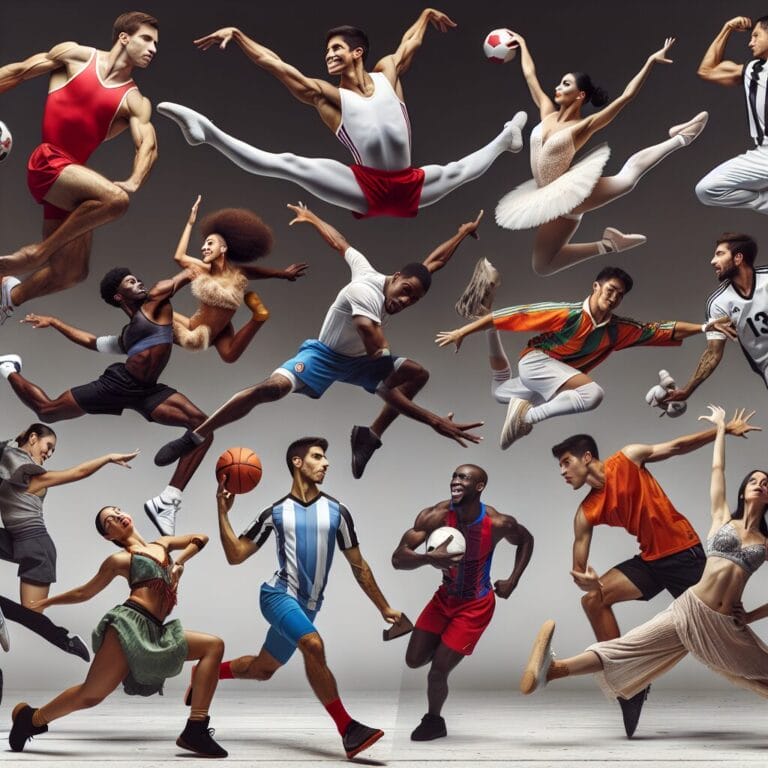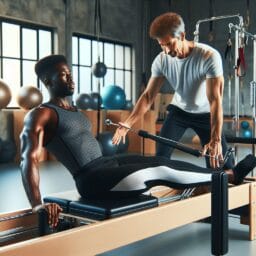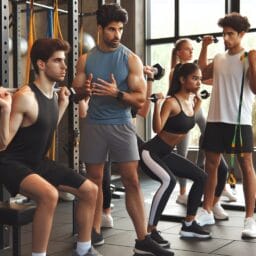
Boost Your Athletic Edge: How Dance Fitness Enhances Competitive Performance
Table of Contents
- Introduction
- The Connection Between Dance and Athleticism
- Dance Fitness Components That Enhance Athletic Performance
- Dance Fitness Training Techniques
- Case Studies: Athletes Who Dance
- How to Get Started with Dance Fitness
- Potential Challenges and How to Overcome Them
- Conclusion
- Frequently Asked Questions
Introduction
Hey there, sporty friends! Did you know that pro football teams are now grooving to the beat? That’s right! Instead of just lifting weights or running laps, they’re incorporating barre work and hip-hop moves into their training plans. Why? Because dance fitness is like a secret weapon for athletes! When they practice dance, they boost not just muscles but also brains. We’re talking about sharper reflexes, lightning-fast agility, and off-the-charts balance—super important stuff for dodging tackles or scoring goals.
But wait, there’s more! Dance isn’t just about hopping around; it’s serious business for your heart too. Cardiovascular fitness gets a mega boost from all those upbeat Latin dances or ballet leaps. And speaking of ballet, imagine having the body control of a professional dancer—pretty cool, huh? Athletes who sprinkle some dance magic into their routine often see performance improvements that leave others in the dust.
Plus, let’s not forget how fun it is to shake it in a dance class after a tough day of drills. It keeps training fresh and exciting. So next time you’re plotting out those training schedules, think about setting goals that include mastering some slick dance movements. You might just find yourself leading the pack with style and a smile!
The Connection Between Dance and Athleticism
Have you ever wondered how some athletes seem to have that extra spark, that ounce of pizzazz that sets them apart from the rest? It could very well be their secret dance moves! That’s right, incorporating dance into sports training isn’t a brand-new idea; it’s an age-old practice with a modern twist. Historically, dancers and athletes have shared common ground—both need extraordinary physical skills like flexibility, stability, and agility. But today’s athletes are taking cues from professional dancers by including targeted dance forms like ballet for poise and Latin dance for rhythm in their training regimens.
As these sporty stars jump and jive in dance fitness classes, they’re not just learning new movements; they’re building muscles with precision. Every plié and pirouette is meticulously designed to enhance core strength and balance. Athletes who dance also develop a heightened sense of spatial awareness which translates directly to avoiding collisions on the field or court.
But wait—dance does more than just prep those legs and lungs; it tunes up the mind too! Dance in sports training can lead to major mental wins; it’s about getting athletes fired up but focused, loose but locked-in during game time. The emotional perks? They’re huge! Studies show that engaging in this kind of physical activity can zap stress faster than lightning. Plus, busting out hip-hop moves after a serious strength-training session spreads good vibes all around!
Coaches across the board are now setting goals that include proper technique in dance to help protect against injuries (think fewer ACL tears). And when we say ‘proper,’ we mean it because practice makes perfect—and safe! The key is tracking progress without pushing too hard too soon; understanding the learning curve helps avoid mishaps while still scoring big on performance improvements.
So next time you see those pro football teams timing their takedowns or runners leaping over hurdles like pros, remember: Those killer moves might’ve been honed not only in traditional drills but also in lively dance classes where every beat counts toward becoming champions at their sport performing arts—the ultimate blend of artistry, athleticism, and pure heart-pounding action.
Dance Fitness Components That Enhance Athletic Performance
Did you know that many of the world’s top athletes share a secret with some of the most graceful ballet dancers? It’s all about flexibility and range of motion, my friends! Imagine being able to bend, twist, and stretch more than ever before—dance fitness makes it possible. Athletes who incorporate dance into their training schedules not only step up their game but also dodge injuries like pros. Why? Because those awesome moves from hip-hop to salsa are secretly giving them superhero-like flexibility!
Now let’s talk core strength and stability—without them, an athlete might as well be a wobbly bowling pin waiting to get knocked down. Here’s where dance training slides in smooth as silk. Picture this: A professional football player, muscles rippling, doing pliés at the barre. Sounds kinda funny, right? But he’s on to something! Those pliés are turning his core into an iron fortress. Ballet techniques used in dance classes pack a punch for building that essential power center of the body.
Balance and coordination are next on our hit list because without them, even the strongest athlete can take a tumble at the worst possible time—like when they’re about to score! Training plans that blend dance movements into sports drills teach athletes how to harness control over their bodies with elegance and precision. Each carefully choreographed step in a dance class trains muscles and mind alike, ensuring every leap or dash during gameplay is calculated perfection.
We can’t forget about endurance and cardiovascular health if we want our athletes going strong till the final whistle blows! Latin dance isn’t just spicy fun—it jacks up heart rates and builds stamina that lasts. The rhythm gets blood pumping efficiently throughout the body, meaning more oxygen for tired muscles when it counts—a true lifesaver during overtime.
As for agility and reflexes, imagine reacting faster than a cat chasing a laser pointer—that’s what athletes practice dance for! Quick footwork from sizzling salsa steps to hip-hop grooves sharpens those instincts so that when it’s crunch time on race day or match day or any day—their bodies respond like lightning!
But wait—there are mental and emotional benefits too. When an athlete steps into a dance fitness class after hours of routine physical drills or strength training sessions feeling mentally drained or physically sore, they tap into powerful stress-busters and morale boosters. These vibes don’t just stay in class; they spill over to competition days too!
So if you’ve ever thought dance was just tutus and tiaras think again! From professional dancers’ enviable muscular tone to top-notch sports performance worthy of champions—the marriage between athleticism and artful movement is one made in heaven. If you’re still not convinced about sliding those fancy feet onto the dance floor as part of your training resulting in lower injury rates (goodbye ACL tears!), higher spirits (hello happy hearts!), then I don’t know what will convince you!
Athletes worldwide now understand: incorporating barre work or mastering the rhythm of Latin dances isn’t just “nice-to-have,” it’s essential for staying competitive at peak levels while keeping training fresh—and way fun! So go ahead—put those dancing shoes on your workout playlist because today’s smart sport performing arts combo could have you pirouetting past your personal best before you know it!
Dance Fitness Training Techniques
Did you realize that ballet could have more in common with basketball or soccer than with the stage? It’s all about body control. When athletes engage in ballet, they’re not just tiptoeing around; they’re upgrading their precision and grace on the field! This dance form teaches them to move intentionally and fluidly—qualities that make a big difference when dodging opponents or aiming for a goal. Plus, ballet’s emphasis on posture and alignment can lead to fewer injuries. But it’s not enough to know this—you’ve got to weave it into your training plan smartly!
Now let’s break down hip-hop, which is more than cool moves and beats. It’s a high-intensity workout challenging athletes with rapid directional changes, enhancing agility and reaction times. And here’s a power move: hip-hop pumps up cardiovascular fitness too! Those energetic routines are like sprint intervals, making hearts healthier and bodies ready to outlast competitors.
Latin dance steps into the training spotlight by teaching athletes something vital—rhythm. Ever noticed how some sports stars seem naturally in sync with their environment? They’ve likely mastered rhythm through Latin dance, improving coordination that makes every pass sharper and every strike more accurate. Learning curve aside, adding salsa or bachata to your schedule could be your ticket to syncing up your game-time movements.
So how do you mix these dances into your regular practice without missing a beat? Start by setting realistic goals that match dance moves with sports skills you aim to enhance. Track progress but listen to your body: don’t rush it or risk an injury from doing too much too soon. And shake off any stigma; embracing dance as training doesn’t make you less of an athlete—it makes you a smarter one.
The benefits for athletes lie not only in muscular tone but also in mental resilience forged in dance classes. Athletes who dance navigate pressure-cooker moments during competition with the same cool head needed for performing arts onstage—both require poise under the spotlight.
Remember (just this once!), incorporating barre work isn’t merely for aesthetics; it’s serious athletic business offering crucial stability for those unexpected pivots during gameplay. Dance training equips your body with dynamic strength—and tosses monotony out of traditional workouts.
Whether perfecting pliés or popping-and-locking in hip-hop style, each variety of dance brings something unique to the table—or rather, the field or court—that goes beyond physical activity alone. So grab those dancing shoes alongside cleats and trainers; striking that entertaining yet effective balance between sport performing arts may just elevate your athletic narrative toward standing ovation-worthy feats!
Case Studies: Athletes Who Dance
Let’s slide into the spotlight one cool fact: even tough athletes who tackle fields and courts have discovered that dance moves are like a superpower for their game! Picture this—a professional basketball player twirling in a pirouette. Seems out of place, right? But guess what? That turn is turbo-charging his balance and giving him cat-like reflexes when it’s time to pivot past defenders. Athletes who twist and twirl learn to land on their feet, ready for anything!
Now there’s Zack, a soccer champ who thought dance was just fancy footwork until he tried it. After adding some hip-hop flair to his workout routine, he found himself zooming across the field with newfound spryness! It’s all thanks to those popping beats making him zip around like a whirlwind. And folks at the gym can’t stop talking about Mia, the track star who swapped her running spikes for ballet slippers once a week; now she leaps hurdles with the elegance of a deer!
Deep dives into data are telling us more: turns out when professional football teams mix up crunches with pliés or sprints with salsa steps, they’re not just busting boredom—they’re boosting performance stats through the roof! The proof is in those touch-down dances that look more polished than ever.
Dance classes aren’t just fun zones either; they’re high-octane labs where athletes experiment with rhythm and flow, learning movements that make every muscle sing in harmony—that’s better endurance and an energy boost without extra huffing and puffing on treadmills.
So if you’re thinking about joining the ranks of these smooth-moving sports pros, remember—even though we’re keeping things light here—serious gains come from grooving to that beat. Dance training may trick you into working harder because it feels like playtime but trust us (and ask any coach worth their whistle), incorporating dance into your training plans could be your secret draft pick for an MVP season!
| Athlete | Sport | Type of Dance | Benefits |
|---|---|---|---|
| Unnamed Basketball Player | Basketball | Ballet (Pirouettes) | Improved balance and reflexes for pivoting |
| Zack | Soccer | Hip-Hop | Enhanced agility and speed on the field |
| Mia | Track and Field | Ballet | Graceful hurdle leaps and better endurance |
| Professional Football Teams | Football | Various (Ballet Pliés, Salsa) | Performance enhancement and entertaining touchdown dances |
| Summary: Incorporating dance into sports training improves endurance, balance, agility, and overall performance. | |||
How to Get Started with Dance Fitness
Hey, did you know that spinning and twirling isn’t just for dance floors? Athletes are catching on that those smooth moves from a dance fitness class can seriously up their game. When they scoot into a samba or bounce through a hip-hop routine, they’re not only having a blast—they’re building up super-strong hearts and lungs. Yep, cardiovascular fitness goes through the roof with these groovy workouts, giving athletes the endurance to keep going when others start to huff and puff.
If you want to join the cool kids and make dance part of your sports training plan, here’s the deal: start by finding a dance class that feels like fun! Whether it’s ballet for grace or hip-hop for speed, pick one that makes you excited to move. Just remember to add it into your week bit by bit—no need to go from zero to tango star in one day. And while you’re hopping and bopping, set some goals (nothing too crazy) then keep an eye on how you’re doing so you can high-five yourself as you get better!
Most importantly, give yourself a break if this whole ‘dancing athlete’ thing feels odd at first. It’s okay if you step on toes or miss a beat—nobody becomes a pro overnight. Plus, leaving room for oopsies means no boo-boos (we mean injuries). So why not shimmy away those old-school training blues? Join the party where sports meet art—it might just lead to your next personal best with some extra pep in your step!
Potential Challenges and How to Overcome Them
Leap into the world of dance fitness where athletes find their rhythm for top-notch performance! Forget any old stigma—nowadays, smart sports stars know that mastering pliés and popping moves can make them unbeatable. Learning to dance is like adding secret sauce to your athletic skills, but hey, it might feel tricky at first. Just like learning to ride a bike or skateboarding down a ramp, getting into the groove has its twists and turns. Fear not! With patience and practice, those dance steps will start feeling less like funky chicken moves and more like smooth moonwalks.
To stay safe on this boogie journey, zero in on nailing the proper technique from day one—think of it as wearing a helmet for your muscles and joints. Coaches are saying loud and clear: bending and twirling with care means no owies later! So get ready to bust a move with confidence; dance fitness isn’t just about adding sparkle to your training—it’s about keeping you in the game longer, stronger, and injury-free. Let’s get those feet happy and hearts thumping to the beat because when you dance out onto that field or court, you’ll be playing like a pro who knows all the right moves!

Conclusion
Here’s a fun twist for athletes thinking about dance fitness: imagine your body as one big happy team where every muscle is a player ready to score big. Picture twirling into those tricky turns on the field or holding your balance like you’re glued to the ground—dance moves make that happen! Ballet’s poise, hip-hop’s swift steps, and Latin beats train you in ways drills just can’t match. Not only will dance jazz up your practice, but by focusing on reflexes and rhythm, it could help you zip past others with less huffing and puffing. So why not shimmy into a dance class? You’ll gain muscles that are snappy, hearts that don’t quit, and maybe even some friends who love to groove as much as they do scoring goals. Plus, if you’re worried about tripping over two left feet – fear not! Dance fitness is all about progress; each step forward makes you steadier in sports and life. Give it a whirl, bend it like ballet dancers, and watch your athletic story leap to new heights!




